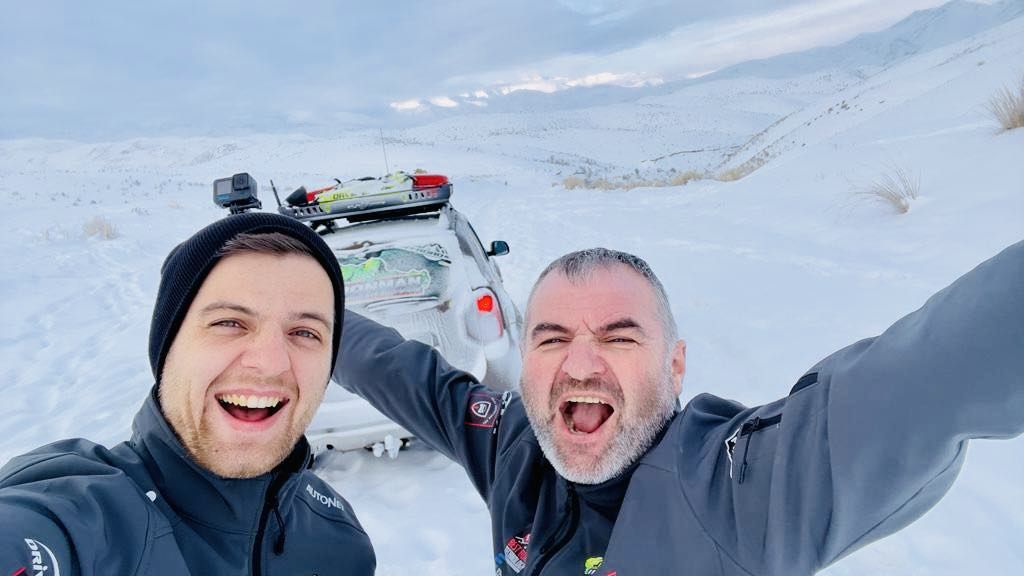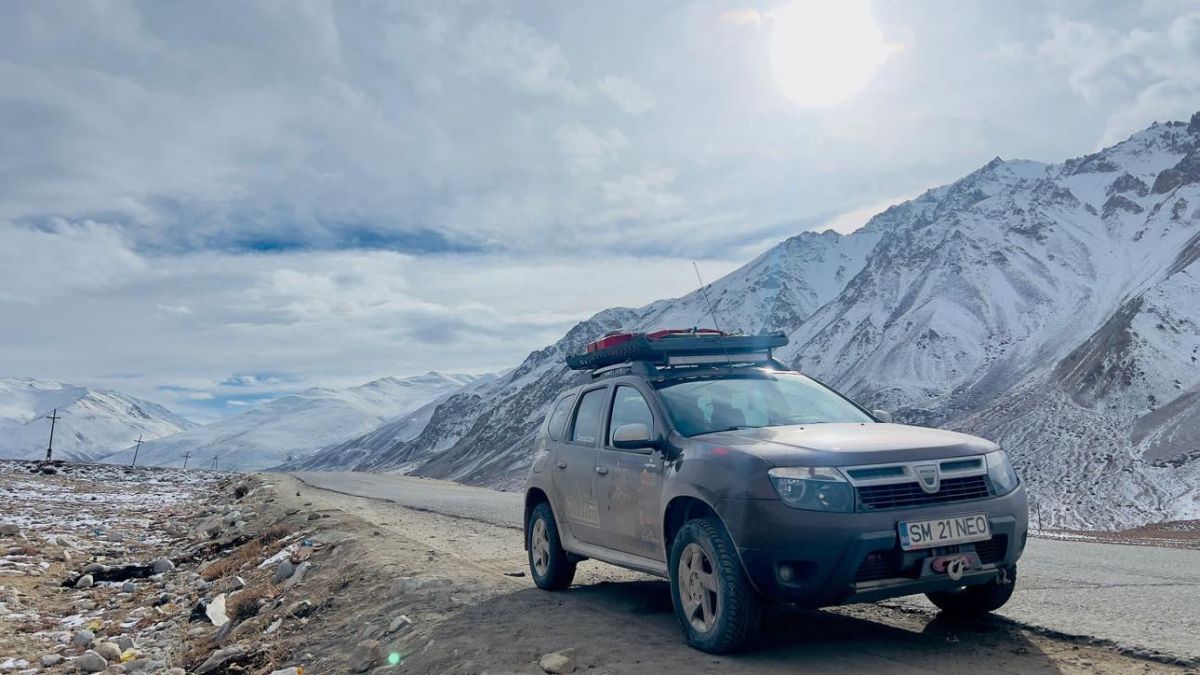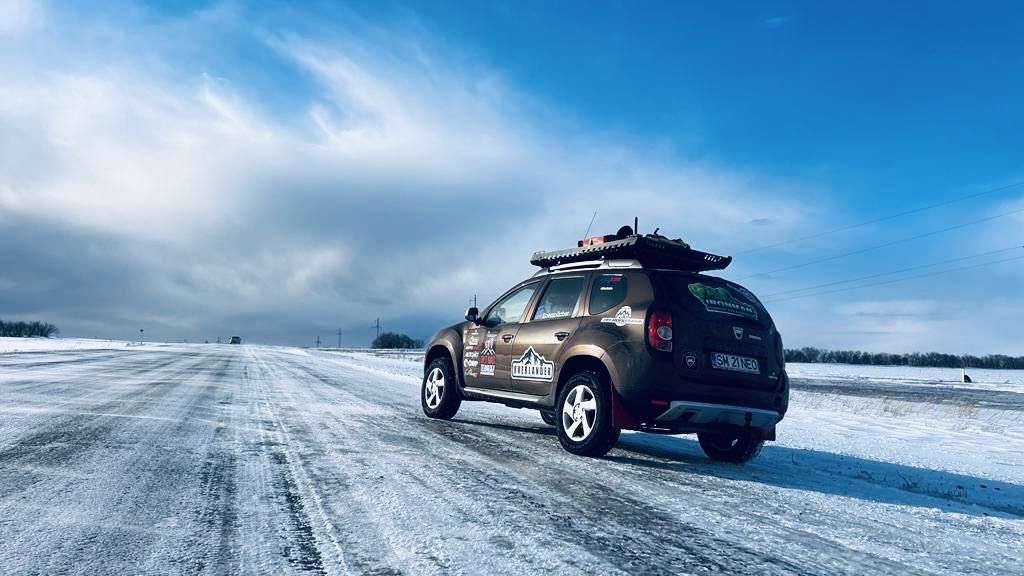
Two Romanians from Satu Mare who went on expeditions in the Far East are now back in the country after covering more than 17,000 km in six weeks in a 13-year-old Duster, reaching an altitude of 4,600 meters in Tajikistan, as well as on the border with Afghanistan. where Afghan villages could also be seen from the infernal path. In which country did cows stand in the middle of the road? How is it after sleeping on the floor at 7 degrees Celsius? Where was the snow an impenetrable wall?
We were so sick that we wanted to go to a hospital in Tajikistan
Attila and Norby Bertici traveled more than 17,500 km in 38 days, passed through 15 countries and had no problems at the borders, with one exception: a 17-hour wait at the entrance to Russia, where there was a huge queue. We drove a Duster 1.6 gasoline 2011 model year, the Duster was bought shortly before the adventure trip. The departure was from Satu Mare.
After each day, Attila Bertici posted a YouTube video of what happened on the road that day. More than 35 episodes are collected, in which you can see the roads, the cities visited, the most special places on the route and places to stay overnight. Since they did not have a generous budget, they often ate salami, cheese, bread and canned food in the car. They also slept in the car and only went out to restaurants a few times.

Photo source: Bertici Attila
The word expedition is NOT an exaggeration. Two people – a father and a son – left alone with a Dacia SUV to areas where you can’t find a city for hundreds of kilometers. Attila Bertici told HotNews.ro about the most interesting moments.
The expedition aimed to reach a very high point on one of the most dangerous roads in the world: the Pamir Highway. The highest point is Ak-Baytal pass (4655 m) in Tajikistan. They traveled almost 10,000 km from Satu Mare to the high pass.
What was it like at a height almost twice as high as the top of Moldovian? The car “pulled” harder, there were climbs of more than 15 degrees, but there was no snow, the winter of 2024 was extremely dry.
What does thin air feel like? “It was much harder to breathe. We climbed the day before to 3700 m for acclimatization and at first we didn’t feel anything, we thought it would be fine. Well, when we climbed to more than 4000 m, it was already felt, and the next day, when we stayed with the locals, we slept on the floor at 7 degrees in the room, because the locals, as Muslims, do not have beds in the house, but carpets “, – says Attila Bertici for HotNews.ro.
“I also had a cold and in the morning I had a headache that made me pass out and our host told us that the locals also get sick in the winter when the altitude is much stronger.”
It must be said that in the countries of Central Asia, tourism has grown significantly, visas are easier, and local residents are happy to welcome foreign tourists. At this time of the year, however, it is not the season, most boarding houses are closed, and the open rooms are cold, because there are (too) few tourists and the heating is not turned on.

Photo source: Bertici Attila
Attila Bertici says that those two days at more than 4,000m were the hardest, feeling sick and coughing so much that at one point they wanted to go to a hospital in Tajikistan. There was no need because they recovered when they descended further to sea level.
Too much snow and a great road from the Afghan border
The critical moment of the adventure was on a snowy secondary road in Kyrgyzstan, where they continued to climb, hoping to avoid a detour of more than 600 km by choosing a much more direct route. There was too much snow, too much slope, and the car was not able to climb from 2800 m because there was too much snow.
It was risky there if the car couldn’t get out of the snow because there was no one to help and no phone signal. They turned off the road and took a longer (but feasible) route several hundred kilometers to the city of Osh in Kyrgyzstan.

The most beautiful and spectacular part of the adventure was the road in the mountainous area on the border between Tajikistan and Afghanistan. The road is narrow and full of twists and turns, the Panj river that separates the two countries was a beautiful color, and from Tajikistan the two Romanians could clearly see the border villages from Afghanistan because they were across the river.
“Afghan villages seemed to me to be poor, but organized. They had fences, there were people on motorcycles. The border guard told us that drugs are being traded because the Afghans are the leaders in this industry, and the area is full of border guards and armed people,” says Attila Bertici.
They drove 250km on this border road in eight hours and could have taken even longer as the road was closed for five hours if they did not reach a certain barrier by 1pm. It was closed because a new road was being built with Chinese funds, and traffic was blocked for several hours a day due to controlled explosions and other works. In two or three years, the problematic road will be replaced with a new one.
The road is nice through the mountains, but risky as there were many trucks coming from the opposite direction and the Duster had to be positioned in such a way that the trucks had room, but this also meant that the Dacia car was very close to the edge of the road, to the chasm,
Bertici also says that in Dushanbe, the capital of Tajikistan, he was told and shown huge apartment buildings built by the Chinese, neighborhoods where no one lives because the locals cannot afford to buy apartments there. To make way for these new buildings, many old buildings were demolished, according to the “recipe” applied by Ceausescu in Bucharest 40 years ago.
A large part of this Chinese investment in the “states”, i.e. the states of Central Asia, is that roads are also being built, and the roads are badly needed, existing in poor condition, with many turns and steep slopes.

It must be said that the 17,500 km adventure has NO direct connection with the Automobile Dacia company. The company did not advertise or financially support him in any way.
Iran and Afghanistan were too dangerous
The two natives also wanted to go through Afghanistan and Iran, they were making moves in that direction, but the attack in Iran on January 3 made the situation unstable. Bertici says it is theoretically possible to drive into Afghanistan without a guide, but locals in Tajikistan told them it would be risky because they could be attacked by people with radical views.
Immediately after the attack, the Afghan guide they spoke with raised the price from US$100 a day to US$250, which would mean a lot of extra expenses for the planned four days.
In Iran, the authorities asked them about the exact route they would take, and the originally planned route would have passed near the city where the attack took place, so the issue could no longer be raised, but an even more circuitous route had to be chosen.

For reasons of safety, money and time, the expedition could no longer reach Iran and Afghanistan, so Attila and Norbi passed through Uzbekistan, visiting the famous cities of the Silk Road – Samarkand and Bukhara. They really liked Uzbekistan: the central square of Samarkand is beautifully lit at night, and in Bukhara they stayed in a five-star hotel for only 18 euros.
Georgia, the country of contrasts – the luxury of “Vegas” and cows on the track
On the way, they were also stopped by the police for checking, but when they saw that they were tourists, they were allowed to go on. The largest number of militias was in Kazakhstan. Made famous by the movie Borat, this country has changed tremendously since 2019, when Attila and Norby first visited it on the Dacia. “This is a completely different country, they have new roads, everything is different. It is interesting that where there were new roads, we often saw the EU flag in Kazakhstan,” says Bertichi.
Where were the bad roads, and where was it difficult to drive? In Georgia, there were many cows on the highway, there were many stray dogs, drivers do not follow the rules, they are constantly overtaking. In Batumi – a Georgian city on the shores of the Black Sea – there was a huge contrast between luxurious and super-lit hotels with dozens of floors and within a five-minute walk there were poor and squalid neighborhoods. “I was shocked by Georgia, if you walk a few minutes from the new center, in Batumi, it was cabbage, it was a disaster.”
They traveled several thousand kilometers through Russia, over 2 thousand kilometers through Kazakhstan. We also drove through Chechnya, where there were no problems, and the roads were in good condition, and the capital Grozny looked very modern from the “rush” of the car.
The car averaged 9.5 liters of petrol per 100 km and has had no problems with it, and Bertici says he plans to keep this Duster and take it on very long trips. The price of gasoline fluctuated greatly, from the equivalent of less than 40 eurocents per liter to 1.2 euros.
They spent about 4,000 euros on the road, and the preparations cost about 2,500 euros. Donations made on Revolut by people who watched the vlogs every day also helped them financially.
Attila Bertici reached 4,700 m with his son Norby, the maximum point of the expedition, exactly four years after another maximum point, in early 2020, when he also reached the world “pole” of cold Oymyakon on Duster (Siberia). ). Since then, he carried out the expedition together with his wife Kinga.
Bertici Attila makes the third campaign to the east. In the autumn of 2018, he was also with his son Norbert (Norby) on the route Satu Mare – Vladivostok – Satu Mare, covering a total of 29,800 km in 40 days. The expedition five years ago was with a 2005 Logan, which gave them a lot of problems, mainly because the car stopped suddenly and did not start immediately.
Source: Hot News
Ashley Bailey is a talented author and journalist known for her writing on trending topics. Currently working at 247 news reel, she brings readers fresh perspectives on current issues. With her well-researched and thought-provoking articles, she captures the zeitgeist and stays ahead of the latest trends. Ashley’s writing is a must-read for anyone interested in staying up-to-date with the latest developments.